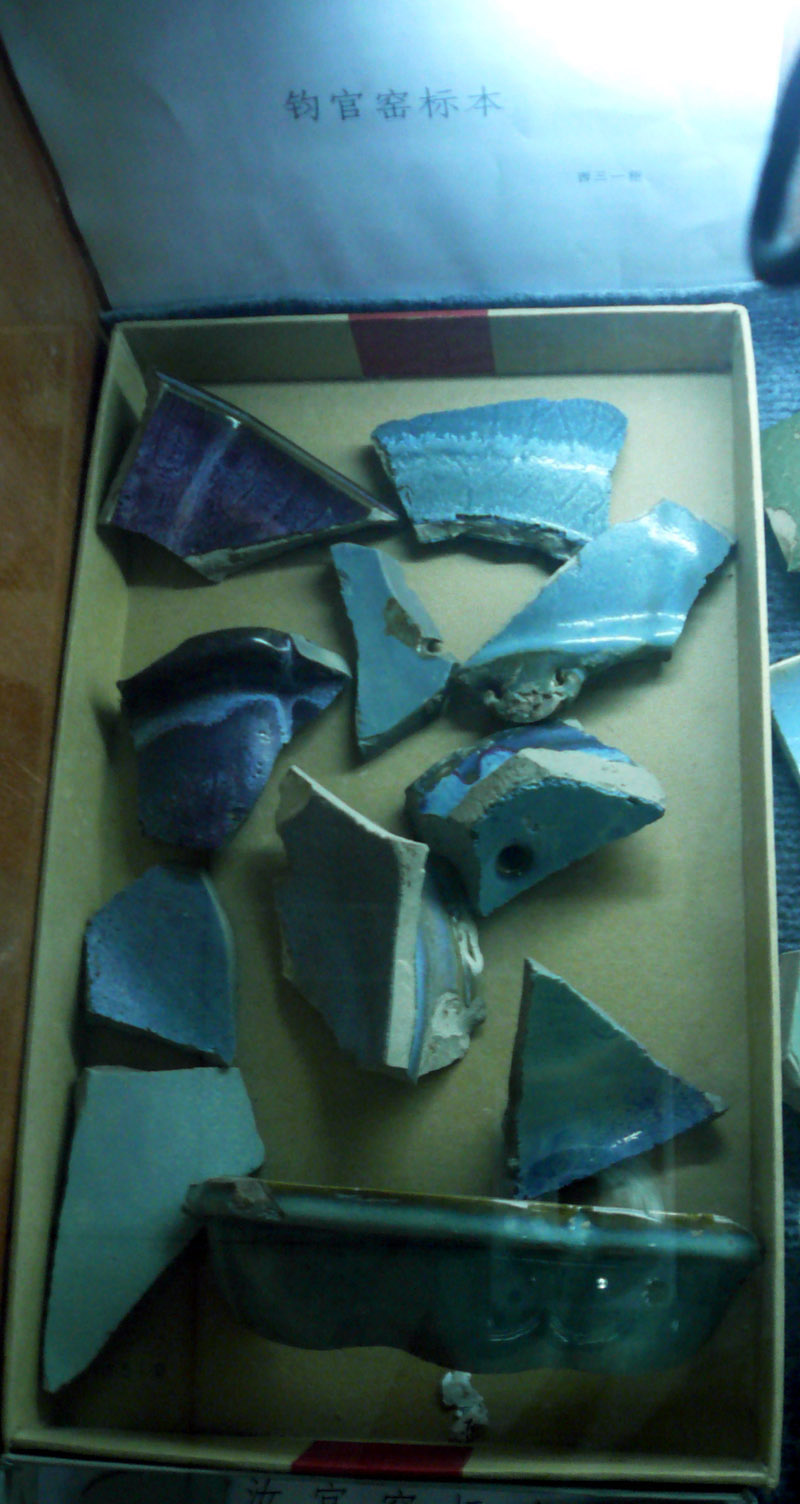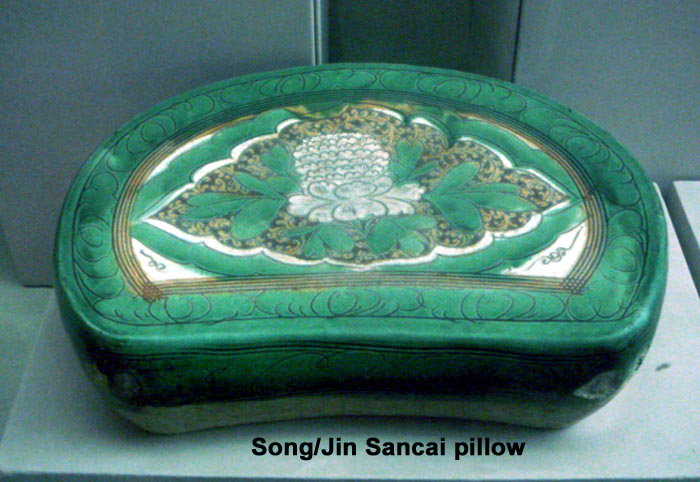
Henan Ceramics wares (河南陶瓷)
Song/Jin period
During the Northern Song Period, the capital was at Kaifeng in Henan. Henan became the economic and cultural centre of the Song empire. Commerical activities was encouraged and this benefitted the handicraft industries. Hence, there was also further development in the ceramics industries with more kilns set up to cater to the increasing consumer demand. Cizhou-type, Sancai, black glaze,Jun, Ru and Yaozhou wares emerged as the main types of porcelain produced. Among them, Ru and Jun wares ranked among the most definitive Henan ceramics wares. Ru ware was also specifically selected for palace use. This was stated by Ye Zhi in his writing "tan zhai bi heng" "坦斋笔衡". He further mentioned that the capital (jing shi 京师) built its own kiln which was called guanyao ,ie guan (official) kiln. This official kiln was likely in Henan but its location has yet to be established.
When the Jin conquered Northern China, many people including skilled craftsmen and potters fled to the South. The porcelain industry suffered temporary set back especially during the period when the Jin and Southern Song were at constant war. But Jin Dynasty entered its prosperity phase during the reign (A.D 1161 - 1189) of emperor Jin Shizong (金世宗). He was an enlightened emperor. Under his and his successor, Jin Changzhong's ( 金章宗) rule (A.D 1189 - 1208), the economy prospered and there was peace with the Southern Song regime. The Henan porcelain industry which suffered from the prolonged period of wars with the Southern Song, benefited from the subsequent economic boom. The ceramics wares during this period was of good quality. Other than Ru wares, all the types mentioned earlier continued to be produced.
So far, at least around 500 kilns sites have been discovered in Henan itself. Most of the kilns in Northern China switched to coal as the fuel to fire the ceramics from Northern Song onward. Trees as a source of fuel became infeasible as prolonged cutting of trees in the past has greatly reduced their availability. The ceramics were mainly fired under oxidising atmosphere and hence the white wares tend to show a light yellowish tone.
In Henan, the number of kilns in counties such as Ruzhou (汝州), Yuzhou (禹州), Hebi (鹤壁), Jiaozuo (焦作) and Defeng (登封) were numerous.
Ru ware
According to Lu You (陆游), who lived during the late Northern to Early Southern Song period, in his writing "Lao Xue An bi ji" "老学庵笔记" he mentioned that the imperial palace used only Ru ware after Ding ware was deemed unsuitable due to the rough rim. The Chinese archaeologists tried in vain to locate the kiln in the early days. It was finally discovered in 1987 at Baofeng Qingliangsi (宝丰清凉寺). The sixth excavation in 2000 uncovered 15 kiln furnaces, two workshops and large quantities of Ru ware specimen and kiln furniture. The shard specimens match those extant ru wares in the Palace collection. The glaze usually has a slightly opaque smooth texture but could be more transparent and glassy when fired at a higher temperature. With good reduction atmosphere, it has a pleasant sky blue hue. Most tend to develop fine crazing, with some having the broken ice effect (the chinese aptly called it the fish scales effect). The vessel is supported by fine spurs and this left the fully glazed base with a ring of 3 or five sesame seed shaped ash gray mark.


Views are divided on whether ru wares were made by folk kilns for the Imperial Palace or Guan (official) kiln established and managed by the Court. Based on the finds at the Qingliangsi site, besides typical sky blue glazed Imperial wares, there were also those with pea green glaze. Some Ru wares were also found to be decorated with carved/incised or molded motif. Most experts held the view that the Qingliangsi Ru products for the Court were tribute ware. Only the best were selected for Palace use and the rest available for use by the common folks.
In fact, ru type glaze wares were also made in other Ruzhou kilns. The glaze texture is very similar to a typical Guan Ru but were of poorer quality. I collected two samples in Ruzhou Tanggou (汝州唐沟) when I visited the site in 2009. They were more yellowish blue in tone as compared with the typical 'Guan' Ru.
The location of the Northern Guan kiln is still shrouded in mystery. In 1999/2000, two sites which produced Ru type wares were discovered at Zhanggong Xiang (张公巷) and Wenmiao (文庙) in Ruzhou. Despite the many similarities, there were also discernable differences. The body is whiter and the glaze is more transparent. For those which are fully glazed, the spur mark is millet-shaped instead of the typical sesame-shaped. There are also those without the glazed footring. The quality of the specimens are excellent and definitely not ordinary folk kiln wares. There are speculations that Zhanggong Xiang (张公巷) may be the site of Northern Song Guan ware.
For more information on Ru ware, please read this.
Jun wares
The Jun kilns at Baguadong (八卦洞)and Juntai 钧台), both located in Yuzhou (禹州) , are believed to produce wares for the Palace. Such wares have been given the name Guan Jun. The glaze is fired to a opacified bluish colour or opacified bluish glaze with red or purplish splashes. Vessels included flower pots, washers, dishes, censor, bowls, zun and etc. Some of the flower pots/stands have number (1-10) carved on their base. It has been established that the number is an indication of the size. Some vessels also have inscription such as fenghua (奉华)and sheng fu (省符). Guan Jun is still a controversial subject with increasing more experts questioning the Northern Song attribution and opined that there were likely produced during the late Yuan/early Ming period.

Guan Jun samples
From field surveys, it is observed that the Song/Jin Jun kiln sites were mainly located in Ruzhou (汝州)(previously called Linru) with those in Dayu Donggou [大峪东沟] produced the finest Song/Jin Jun wares and Wu Gongshan [蜈蚣山] a distinctive moonwhite glaze with red/purple splashes). Other important sites were in Yuzhou (禹州)(most notable site is Liu Jiamen [刘家门]), Lushan (鲁山)(notable site include Duandian) and Dengfeng.
The typical Song/Jin Jun ware has a smooth bluish colour. The Jun glaze contains iron-oxide as the colourant. Under normal circumstances it should produce either a greenish or yellowish/brownish colour. What we see is actually a form of optical blue, similar in principle to the blue of the sky. Scientific analysis revealed that the glaze composition consisted of lower alumina ranging from around 14 to 11 %. Prof. David Kingery and Dr Pamela Vandiver, both from Massachusetts Institute of Technology, observed that glaze within a range of mixture of silica, alumina, calcia and potassia induced a state termed liquid-liquid phase separation during cooling. The micro-structure showed that liquid-liquid phase separation glaze looks like caviar or frogspawn glass droplets which scattered light. Through an interference effect termed Rayleigh Scattering, they scattered blue light
However, there are also those fired to a greenish colour. The locals treated them as a category separate from Jun and termed it Lu Jun ie, green Jun. Strictly speaking, what one see is the actual colour produced by iron-oxide. It is no different from the normal green glaze/celadon ware. They are unlikely to be mis-fired Jun wares as the quantity in existence is large. Henan potters were aware of the respective glaze formula to induce the required effect.
Samples of Green colour Jun
The glaze quality of Song/Jin Jun is smooth with very small bubbles in the glaze. They are more thinly potted with thinner and well-form foot and usually have glaze on the outer bottom.
Jin Jun Censers
Without closer examination, some of the Jun blue glaze wares could appear quite similar to Ru wares. But on close examination of cross section of the sherds, it is obvious that Jun wares have thicker glaze. The Chinese has a saying, Jun Ru bu fen (钧汝不分) literally meaning it is hard to distinguish between Ru and Song Jun.
For more on Jun wares, please read this article.
Cizhou wares
In 1918 A.D, some villagers from Julu (巨鹿)in Hebei discovered some ancient ceramics while digging a well during a drought spell. The pieces were snapped up eagerly by foreign antique dealers . Over the period from 1918 to 1919, many more pieces were recovered in Julu and sent to Beijing antique market. It was estimated at least half of them were now in Japan. Hobson was the first to identify those wares found in Julu as wares made in ancient Cizhou and suggested the term Cizhou type wares to classify wares that share common key features. From the Chinese source, the earliest ancient text which commented about Cizhou wares was Ming period (曹昭) Cao Zhao's Ge Gu Yaolun ( 格古要论). He wrote that the good ones are similar to Ding ware but without tear marks. There were also those with incised or iron rust colour painted motifs. The ancient texts were vague and did not give a clear picture of the types of Cizhou wares which were made before Ming period.
The typical cizhou ware is identified based of certain features. It has a milky white glaze. There are however some with green or torquoise colour glaze. It utilises one of the following decorative techniques:
incising, incising/combing or carving
sgraffito which involved shaving away surface outside the incised motif to create an embossed or paper-cut effect
underglaze iron black/brown painting or overglazed enamelled red/green/yellow painting.
Plain white glaze Cizhou-type wares
Besides Hebei, Henan had numerous kilns which produced such wares. The famous ones included Xiuwu Dangyangyu [修武当阳峪), Tangyin Hebiji (汤阴鹤壁集), Yuzhou Pacun (禹州扒村) and Dengfeng (登封)].
For those with incised motif, there were also those further decorated with stamped ring-shaped ground. It was introduced during the late Tang period and became popular during the Northern Song period.
Dengfeng Quhe kiln
Samples with elaborately incised motif from Henan kiln
Vessels decorated using sgraffito technique featured among the most impressive Cizhou wares. In its simplest form, the vessel is first applied with a layer of white slip. The motif is then incised and area outside the motif removed to reveal the paste. The vessel is then glazed and fired. Visually, the finished product appeared to be decorated with embossed motif. The more complex type involved the application of two layer of slips, one white and the other black. It required great skills as too much scrapping will show the paste instead of the colour of the lower layer slip. Some of the best sgraffito wares were from Xiuwu Dangyangyu (修武当阳峪) kiln. Another notable kiln that produced some quantity of such wares was Dengfeng Quhe.
Examples using two layers of slip
During the Jin period, wares using incising/carving combined with combing method became popular. Such wares were found in kilns from Hebi (鹤壁), Xinan (新安), Defeng (登封) and etc.
Examples using combination of carving/incising/combing techniques
Example using combinatin of carving/combing technique
Towards the late Northern Song period, white glaze with painted iron black/brown motif emerged. It became one of the dominant product during the Jin/Yuan period. The best products in this category could be found in Yuzhou Pacun kiln (禹州扒村). It is typified by white glaze and glossy black motif. One distinctive vessel from Pacun kiln was large basin with flat rim. The glaze from most of the other Henan kilns tends to have a slightly yellowish colour tone. Some of the iron-painted motif were also covered with torquoise or green glaze. Iron-painted wares were produced in numerous kilns in Henan such as those in Xinmi (新密), Jiaxian (郏县), Yuzhou (禹州), Lushan (鲁山), Yiyang (宜阳), Hebi (鹤壁) and etc.
Pachun kiln basin with fish motif
During the Jin period, wares decorated with overglazed green, yellow and red were introduced. The more notable kilns producing such wares are Xiuwu Dangyangyu (修武当阳峪) and Yuzhou Pacun (禹州扒村). In Pacun kiln, black enamel were also used for some parts of the motif.
The marbled wares which first appeared during the Tang dynasty continued to be produced in Henan. However, instead of the low fired lead glaze, those made during the Song Dynasty had high fired glaze. The kiln which is usually associated with such wares is Xiuwu Dangyangyu (修武当阳峪) .

Sancai wares
Sancai wares originated from Henan Gongyi kiln during the Tang Dynasty. It continued to be an important product during the Song/Jin period. They are usually incised with decoration before application of the various lead glaze colour.


Black Glaze wares
Black glaze ware was another important category of ceramics products found in numerous kilns in China. Those from Northern China have characteristically shiny glaze. One of the most distinctive decorative element is vertical raised lines on the body of vesse. Hebiji (鹤壁集) and Yuzhou Pacun (禹州扒村) were among the first to produce them. Other kilns that produced large number of such wares were Xiuwu Dangyangyou (修武当阳峪) and Lushan Duandian(鲁山段店). Vessels found using such decorative techniques are Hu vases, bowls and washers. Other distinctive and famous decorative techniques included brown splashes and oil spots.

Yaozhou type Linru Greenwares
Henan also produced many Yaozhou (耀洲) type greenware with impressed/carved motifs during the Song/Jin period. They are called Linru greenwares by the Chinese. Linru (临 汝) is now renamed as Ruzhou (汝州). In Henan, majority of the vessels produced were bowls and dishes with impressed floral/waves/waves with fishes motifs or plain without motif. Only small quantity of wares with carved motifs were produced. The motifs were similar to those produced in Yaozhou but are generally of poorer quality. They tend to have a greener or more murky grayish green tone as compared with those from Yaozhou which has a yellowish tinge. Yaozhou version also has a more transparent glaze. Majority of the kilns that produced such wares were in Ruzhou (汝州) , Xinan (新安) and Yiyang (宜阳). Other kilns included Yuzhou Juntai (禹州钧台), Neixiang Dayaodian (内郷大窑店) and (宝丰清凉寺).
The products from Xinan Xiguan kiln (新安西关) were generally of higher quality. Those with carved motif were very good and comparable to their counterparts from Yaozhou.
Some of the Linru bowls have surname character such as 吴, 童 impressed within the circle of a chrysanthemum at the inner bottom.

Continue to: Page 4
Written by : NK Koh (28 May 2010)
References:
1. 中国陶瓷史 - 中国上海硅酸盐学会编
2. 中国古陶瓷研究 (第十五集) - 中国古陶瓷学会编